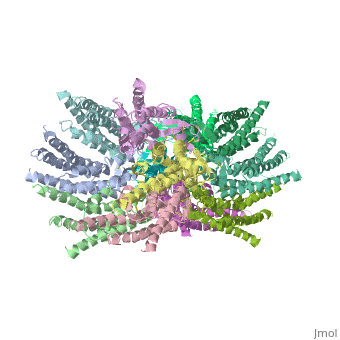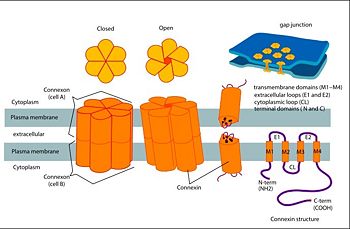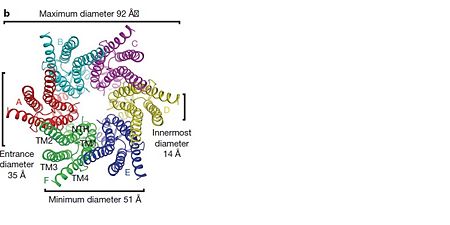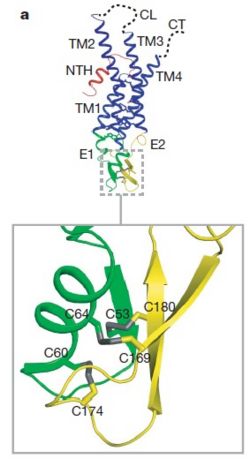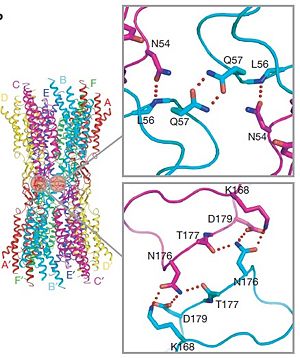Connexin
From Proteopedia
(Difference between revisions)
| Line 13: | Line 13: | ||
=Structure:= | =Structure:= | ||
==Connexin structure== | ==Connexin structure== | ||
| - | <scene name='70/701426/Wild_type_connexin/1'>Connexins</scene> are integral transmembranal proteins which consist of α-helical domains in the <scene name='70/701426/Connexin_26_basic_structure/6'>4 transmembrane segments</scene> (TM1-TM4) , <scene name='70/701426/two extracellular loops/1'>two extracellular segments</scene> (E1 and E2), a cytoplasmic loop, an N-terminal helix (NTH), and a C-terminal segment.<scene name='70/701426/Connexons_secondary_structure/1'>This scene</scene> shows the overall connexon secondary structure. The overall contents of a single unit of a connexin is shown in <scene name='70/701426/Connexin_structure2/1'>this scene</scene>. Each connexin consists of 227 amino acids from the <scene name='70/701426/Connexin_26_basic_structure/3'>N terminus to the C terminus</scene>. <scene name='70/701426/Conxoxn_structure/1'>Six connexins</scene> form a hexamerical assembly, known as <scene name='70/701426/Connexin_26_basic_structure/5'>a connexxon or a hemmichannel</scene> , which delineates an aqueous pore with a minimum diameter of ∼1.2 nm. When two hemichannels from adjacent cells dock and join, leaving a gap of ∼2–3 nm, they may form an intercellular [http://www.uniprot.org/uniprot/P29033 gap junction channel] which spans the two plasma membranes and allows the exchange of cytoplasmic molecules with size up to ∼1 kDa. | + | <scene name='70/701426/Wild_type_connexin/1'>Connexins</scene> are integral transmembranal proteins which consist of α-helical domains in the <scene name='70/701426/Connexin_26_basic_structure/6'>4 transmembrane segments</scene> (TM1-TM4) , <scene name='70/701426/two extracellular loops/1'>two extracellular segments</scene> (E1 and E2), a cytoplasmic loop, an N-terminal helix (NTH), and a C-terminal segment.<scene name='70/701426/Connexons_secondary_structure/1'>This scene</scene> shows the overall connexon secondary structure. The overall contents of a single unit of a connexin is shown in <scene name='70/701426/Connexin_structure2/1'>this scene</scene>. Each connexin consists of 227 amino acids from the <scene name='70/701426/Connexin_26_basic_structure/3'>N terminus to the C terminus</scene>. <scene name='70/701426/Conxoxn_structure/1'>Six connexins</scene> form a hexamerical assembly, known as <scene name='70/701426/Connexin_26_basic_structure/5'>a connexxon or a hemmichannel</scene> , which delineates <scene name='70/701426/Pore/1'>an aqueous pore</scene> with a minimum diameter of ∼1.2 nm. When two hemichannels from adjacent cells dock and join, leaving a gap of ∼2–3 nm, they may form an intercellular [http://www.uniprot.org/uniprot/P29033 gap junction channel] which spans the two plasma membranes and allows the exchange of cytoplasmic molecules with size up to ∼1 kDa. |
The height of the modelled structure of the gap junction channel without disordered cytoplasmic loop and C-terminal segment is approximately 155Å.<ref name='Structure'/> [[Image:distances a.jpg | thumb | 350px |center]] | The height of the modelled structure of the gap junction channel without disordered cytoplasmic loop and C-terminal segment is approximately 155Å.<ref name='Structure'/> [[Image:distances a.jpg | thumb | 350px |center]] | ||
Revision as of 15:35, 19 May 2015
| |||||||||||
References
- ↑ Zonta F, Buratto D, Cassini C, Bortolozzi M, Mammano F. Molecular dynamics simulations highlight structural and functional alterations in deafness-related M34T mutation of connexin 26. Front Physiol. 2014 Mar 4;5:85. doi: 10.3389/fphys.2014.00085. eCollection 2014. PMID:24624091 doi:http://dx.doi.org/10.3389/fphys.2014.00085
- ↑ 2.0 2.1 2.2 2.3 Suga M, Maeda S, Nakagawa S, Yamashita E, Tsukihara T. A description of the structural determination procedures of a gap junction channel at 3.5 A resolution. Acta Crystallogr D Biol Crystallogr. 2009 Aug;65(Pt 8):758-66. Epub 2009, Jul 10. PMID:19622859 doi:http://dx.doi.org/10.1107/S0907444909014711
- ↑ http://en.wikipedia.org/wiki/Connexin
- ↑ 4.0 4.1 Ambrosi C, Walker AE, Depriest AD, Cone AC, Lu C, Badger J, Skerrett IM, Sosinsky GE. Analysis of trafficking, stability and function of human connexin 26 gap junction channels with deafness-causing mutations in the fourth transmembrane helix. PLoS One. 2013 Aug 15;8(8):e70916. doi: 10.1371/journal.pone.0070916. eCollection, 2013. PMID:23967136 doi:http://dx.doi.org/10.1371/journal.pone.0070916
- ↑ 5.0 5.1 5.2 Oshima A, Tani K, Toloue MM, Hiroaki Y, Smock A, Inukai S, Cone A, Nicholson BJ, Sosinsky GE, Fujiyoshi Y. Asymmetric Configurations and N-terminal Rearrangements in Connexin26 Gap Junction Channels. J Mol Biol. 2011 Jan 21;405(3):724-35. Epub 2010 Nov 20. PMID:21094651 doi:10.1016/j.jmb.2010.10.032
Proteopedia Page Contributors and Editors (what is this?)
Safaa Salah Hussiesy, Michal Harel, Doaa Naffaa, Jaime Prilusky
